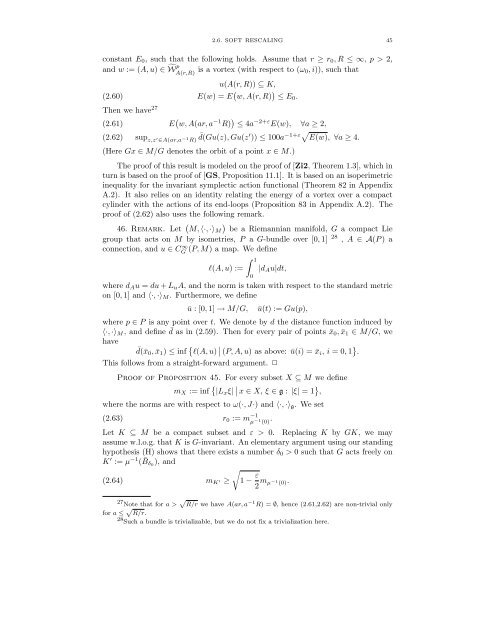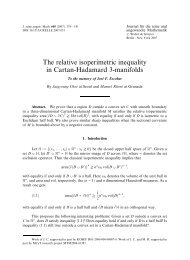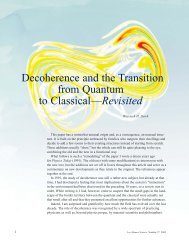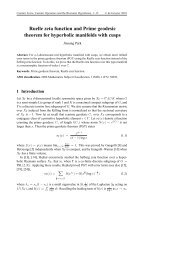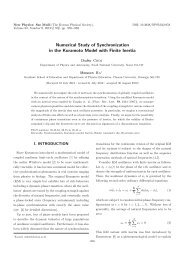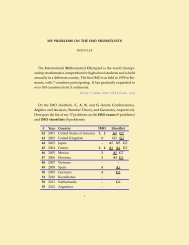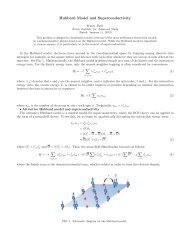A Quantum Kirwan Map: Bubbling and Fredholm Theory for ... - KIAS
A Quantum Kirwan Map: Bubbling and Fredholm Theory for ... - KIAS
A Quantum Kirwan Map: Bubbling and Fredholm Theory for ... - KIAS
You also want an ePaper? Increase the reach of your titles
YUMPU automatically turns print PDFs into web optimized ePapers that Google loves.
2.6. SOFT RESCALING 45constant E 0 , such that the following holds. Assume that r ≥ r 0 ,R ≤ ∞, p > 2,<strong>and</strong> w := (A,u) ∈ ˜W p A(r,R) is a vortex (with respect to (ω 0,i)), such that(2.60)u(A(r,R)) ⊆ K,E(w) = E ( w,A(r,R) ) ≤ E 0 .Then we have 27 E ( w,A(ar,a −1 R) ) ≤ 4a −2+ε E(w), ∀a ≥ 2,(2.61)(2.62)sup z,z′ ∈A(ar,a −1 R) ¯d(Gu(z),Gu(z ′ )) ≤ 100a −1+ε√ E(w), ∀a ≥ 4.(Here Gx ∈ M/G denotes the orbit of a point x ∈ M.)The proof of this result is modeled on the proof of [Zi2, Theorem 1.3], which inturn is based on the proof of [GS, Proposition 11.1]. It is based on an isoperimetricinequality <strong>for</strong> the invariant symplectic action functional (Theorem 82 in AppendixA.2). It also relies on an identity relating the energy of a vortex over a compactcylinder with the actions of its end-loops (Proposition 83 in Appendix A.2). Theproof of (2.62) also uses the following remark.46. Remark. Let ( )M, 〈·, ·〉 M be a Riemannian manifold, G a compact Liegroup that acts on M by isometries, P a G-bundle over [0,1] 28 , A ∈ A(P) aconnection, <strong>and</strong> u ∈ CG ∞ (P,M) a map. We definel(A,u) :=∫ 10|d A u|dt,where d A u = du+L u A, <strong>and</strong> the norm is taken with respect to the st<strong>and</strong>ard metricon [0,1] <strong>and</strong> 〈·, ·〉 M . Furthermore, we defineū : [0,1] → M/G,ū(t) := Gu(p),where p ∈ P is any point over t. We denote by d the distance function induced by〈·, ·〉 M , <strong>and</strong> define ¯d as in (2.59). Then <strong>for</strong> every pair of points ¯x 0 , ¯x 1 ∈ M/G, wehave¯d(¯x 0 , ¯x 1 ) ≤ inf { l(A,u) ∣ ∣ (P,A,u) as above: ū(i) = ¯x i , i = 0,1 } .This follows from a straight-<strong>for</strong>ward argument. ✷Proof of Proposition 45. For every subset X ⊆ M we definem X := inf { |L x ξ| ∣ ∣ x ∈ X, ξ ∈ g : |ξ| = 1 } ,where the norms are with respect to ω(·,J·) <strong>and</strong> 〈·, ·〉 g . We set(2.63) r 0 := m −1µ −1 (0) .Let K ⊆ M be a compact subset <strong>and</strong> ε > 0. Replacing K by GK, we mayassume w.l.o.g. that K is G-invariant. An elementary argument using our st<strong>and</strong>inghypothesis (H) shows that there exists a number δ 0 > 0 such that G acts freely onK ′ := µ −1 ( ¯B δ0 ), <strong>and</strong>√(2.64) m K ′ ≥1 − ε 2 m µ −1 (0).p27 Note that <strong>for</strong> a > R/r we have A(ar, a −1 R) = ∅, hence (2.61,2.62) are non-trivial only<strong>for</strong> a ≤ p R/r.28 Such a bundle is trivializable, but we do not fix a trivialization here.


